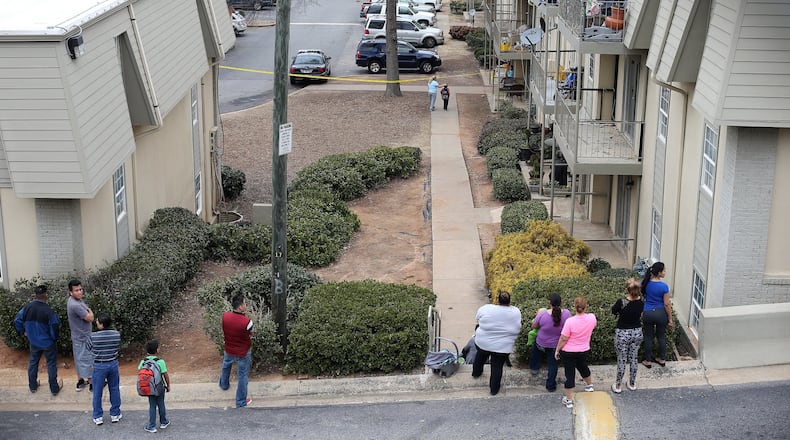Two weeks earlier, community activists in DeKalb County suspected that their district attorney was more interested in protecting bad cops than in prosecuting them.
On Thursday night, as DA Robert James announced the indictment of a DeKalb police officer in the shooting death of a civilian, dozens of those same protesters were cheering the mere mention of James’ name.
Not a bad start for an election year.
But whatever motivated James — the approaching primary this spring, community pressure, the pursuit of justice or all three — he achieved something last week that is more rare than an earthquake in Georgia. The murder charges against Robert Olsen, a white officer who shot and killed a naked and unarmed black man outside an apartment building in Chamblee last year, represent the first time since 2010 that a law enforcement officer in Georgia has been prosecuted in the shooting death of a civilian. (In one other case, a grand jury indicted a Griffin police officer for shooting a man in the back of the head; the district attorney persuaded a judge to dismiss the charges a day later.)
The Hill shooting was among 184 fatal police shootings in Georgia since 2010 documented in an Atlanta Journal-Constitution/Channel 2 Action News investigation published in December. It was the most comprehensive review of police shootings in Georgia history and made public for the first time an authoritative accounting of who is killed and the circumstances surrounding each case.
In many of the shootings, officers found themselves in dangerous situations facing dangerous people. But the AJC uncovered trends that cast doubt about whether every shooting was justified.
In nearly half the cases, the person shot by police was either unarmed or shot in the back. As in Hill’s case, in more than a third of the fatal shootings, the deceased was shot at his or her own home or that of a loved one, often after a call for help.
The number of whites and African-Americans killed was roughly the same, but when population figures were factored in blacks were twice as likely to be fatally shot by police. In DeKalb, a majority-black county, the fact that the officer is white and the dead man was black sparked demonstrations in the community.
Ultimately, the Olsen case likely will hinge on two things: whether deadly force was necessary to protect the officer, and whether Olsen has told the truth about what happened that day.
‘Controlled by the district attorney’
Olsen, 53, is charged in a six-count indictment with felony murder in the death of Anthony Hill, 27. Hill was a military veteran of Afghanistan who was discharged from the Air Force in 2013 when he was diagnosed with bipolar disorder. His family has said that problems with Hill’s medication may have led to his disoriented state on the night of March 9, 2015, when he was shot and killed by Olsen outside the Chamblee Heights apartments.
Olsen, who was dispatched after 911 calls about Hill, has said that Hill was coming toward him and that he refused the officer’s commands to stop. With Hill just a few feet away, Olsen says he opened fire because he feared for his own safety.
The attorney for Hill’s family, Christopher Chestnut, has been critical of the district attorney’s approach to the case. But now, he says, it’s clear James is “all in.”
Others agree.
“The grand jury system is controlled by the district attorney,” said J. Tom Morgan, a former DeKalb DA now working as a criminal defense lawyer. “The fact the case was indicted means the district attorney wanted the case indicted.”
James himseiclf said simply,” I’m no longer neutral. I’ve become an advocate.”
Police offers have a wide latitude under the law to use deadly force, and these cases can be difficult to prosecute. In addition, prosecutors work in partnership with police officers every day to put criminals away, and a vigorous prosecution of an officer can put that partnership at risk. Even in cases in which prosecutors hafe sought an indictment, a state law gives police officers an edge when a grand jury convenes to hear evidence against them.
Alone among the states, Georgia permits officers to attend the entire grand jury proceeding and to make a statement at the end of the hearing. The statement may not be challenged by anyone, and it is the last testimony grand jurors hear before they vote on whether to indict.
‘It’s a really powerful weapon’
Fulton County District Attorney Paul Howard reopened a 2011 police shooting case last year in the hope of obtaining an indictment when he had been unable to do so before. Howard had received new evidence in the death of teenager Ariston Waiters, who was shot in the back by Union City officer Luther Lewis.
But the grand jury denied Howard an indictment a second time.
Grand jury proceedings, in which a panel of citizens decides whether to bring criminal charges after hearing evidence from prosecutors, are closed to the public. Potential defendants are not permitted to attend or take part, unless they are police officers or certain public officials.
Howard said the evidence was neutered by the emotional testimony of Lewis, who invoked his special privilege to listen to all the evidence against him and then offer that unchallenged testimony.
“You can imagine being able to give a statement without cross-examination,” Howard said. “It’s really a powerful weapon.”
In the DeKalb case, Officer Olsen made a 20-minute statement in his defense to conclude the proceeding, his attorney said. But the officer wasn’t able to overcome eight hours of testimony offered by the prosecution.
‘An absolute right to protect themselves’
The long odds that James bucked in securing an indictment will become much longer as he seeks a guilty verdict.
“It’s a tough burden,” Morgan, the former DeKalb DA, said of the prosecution’s case. “Would a reasonable person under the same circumstances that the officer was in believe they were about to receive serious bodily injury? The officer has an the absolute right to protect themselves with the use of deadly force.”
Don Samuel, who joined Olsen’s defense team just last week, said the grand jury did not hear from one witness who told police Hill was “attacking” and “charging” the officer.
“I don’t think there’s any question he was in reasonable fear of his safety,” Samuel said. “Put yourself in his shoes: He’s standing alone and there’s a naked guy, which is pretty scary in and of itself, charging at you. Witnesses have said he yelled, ‘Stop, stop,’ and that he backpedaled, but the guy keeps running at him. Just put yourself in his shoes.”
Samuel said he understands Hill was unarmed and that Olsen had other options to use that did not require lethal force. But that is hindsight, not the heat of the moment when he had only seconds to react, Samuel said.
This will be a key point in the prosecution: whether the jury believes that Olsen was legitimately in danger. The 911 callers said Hill was not threatening them, and witnesses gathered by the Hill family’s attorney have said that Hill’s hands were out and up as he approached the officer.
Persuading jurors that Hill did not represent a threat to Olsen will nonetheless be a high hurdle for the prosecution, experts said.
“When push comes to shove, I think that jurors and even judges are very reluctant to second-guess police officers for split-second, life-or-death decisions in violent street encounters while they are working,” said Philip Stinson, an associate professor of criminal justice at Bowling Green State University in Ohio and a nationally recognized expert on police shootings and misconduct. “If there’s any reasonable doubt, you’re not going to get a conviction.”
Stinson said it’s “amazing there was an indictment presented at all.”
Olsen changed his story, indictment says
Olsen’s initial account of the shooting, as much as the shooting itself, contributed to the case against him, according to statements made by the prosecutor, questions raised by an earlier grand jury and the indictment itself.
Olsen is alleged to have told Officer L. Anderson, who arrived within two minutes of the shooting, that Hill “physically assaulted him prior to the shooting by pounding on (Olsen’s) chest,” the indictment states.
Olsen’s account had changed by the time he testified before a civil grand jury, empaneled in October by James to recommend whether an indictment should be sought. Instead of claiming that he was attacked, Olsen said he feared an attack, believing that Hill was under the influence of bath salts or PCP.
The grand jury took note of that apparent discrepancy, recommending further investigation by James. The October grand jury specifically called for a follow-up interview of Officer Anderson and “a second, more thorough interview to clarify Officer Olsen’s account of events from the GBI interview,” according to a synopsis provided by the district attorney’s office.
James has already seized upon the alleged inconsistencies in Olsen’s account, and his veracity is sure to be a focus of the prosecution’s case.
Ken Vance, executive director of the Georgia Peace Officers Standards and Training Council, said he doesn’t know the specifics of the Olsen case, but he said POST takes a dim view of false statements or anything suggesting that a police officer lied.
“It goes straight to credibility,” Vance said. “You can be impeached on a stand. If you’ve done it before and got caught, you put yourself in a bad, bad situation in law enforcement. Your credibility is your honor.”
Vance said Olsen’s indictment is another indicator of the intense scrutiny law enforcement is facing. He said criticism of law enforcement is at a level not seen in decades, dating back to the civil rights era.
“There’s a change going on in all of law enforcement,” he said. “We’ve got to do a lot more training, particularly in the areas dealing with the mentally ill and use of force.”
About the Author
The Latest
Featured



